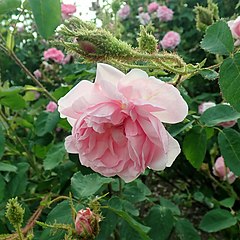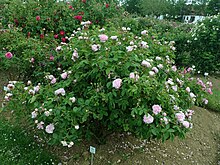Moss rose
| Moss rose | |
|---|---|

Rosa muscosa communis ( Rosarium Sangerhausen ) |
|
| group | Moss roses |
| Breeding year | around 1696 |
| List of rose varieties | |
The moss rose , Rosa × centifolia 'Muscosa', is a mutation of the centifolia Rosa x centifolia L. The moss roses are among the old roses .
history
Early sources suggest that the moss rose had been known in Carcassonne in the south of France for half a century in 1696. It was mentioned for the first time in England in 1724. It was particularly popular in the 19th century, when numerous varieties were created through breeding.
Often planted in traditional cottage gardens in earlier times , today they are a little rarer in gardens. Painted images on old porcelain are evidence of the former popularity of the moss roses .
Appearance
Parsley curls, green leaf outgrowths and the oil glands make the calyx and flower stalks look like moss. This moss - especially the bud that opens - is what makes this rose so attractive for lovers. The resin, which is sticky to the touch, smells very spicy if you rub the leaves and stems between your fingers.
Otherwise the Rosa × centifolia muscosa is similar in shape, scent and color to the mother plant 'Rosa centifolia' (or 'Cabbage rose'), but has slightly smaller flowers. The original and most common color of many moss roses is pink, but with the many varieties that still exist today, the color spectrum ranges from white to rose-red to purple, and very rarely also red.
Most moss roses, like all old roses, bloom once (June – July).
With their disintegrating growth, moss roses can be planted well as solitaires in the lawn or in the background of a border. In fertile soil and airy locations, moss roses are seldom susceptible to powdery mildew ; they tend e.g. T. to soot . Some moss roses are sensitive to rain and tend to form mummies; but occasional heavy rain does not harm them. You have to tie up almost all varieties and support the long shoots. As usual, the cut depends on whether it is single-flowering or remounting . Some varieties are also suitable for smaller gardens, some even for planting in pots .
sorts
Probably the oldest moss rose is the pink Rosa × centifolia muscosa or Rosa muscosa communis , which has been recorded since around 1696 and is also known by other names, including 'Old Pink Moss',' Mousseau Ancien ',' Mousseuse à fleurs doubles' or ' Cent-feuilles mousseux '.
The Rosa × centifolia muscosa alba is a white sport of this ancient moss rose that was discovered by Shailer in 1788. According to Austin, other well-known names for this rose are: 'Shailer's White Moss', 'White Bath' or 'Clifton Rose'. Others believe that the 'White Bath' or 'Clifton' moss rose is not identical to 'Shailer's Moss', but was first created in 1818.
Most of the other varieties were bred in the mid-19th century.
- Rosa × centifolia muscosa (also Rosa muscosa communis , 'Old Pink Moss' and others), around 1696, pink, very hardy;
- Rosa × centifolia muscosa alba (also 'Shailer's White Moss', 'White Bath' or 'Clifton Rose'), 1788, pink;
- ' A Longs Pédoncules ', Moreau-Robert, France 1854, pink
- 'Alfred de Dalmas' (or 'Mousseline'), France 1855, white with a hint of creamy pink, fragrant;
- 'Catherine de Württemberg', 1843, lavender-pink;
- 'Comtesse de Murinais', Vibert, France 1843, white with a hint of pink;
- 'Docteur Marjolin', Robert & Moreau, France 1860, warm dark pink, lighter outside;
- 'Etna', Vibert, France 1845, red;
- 'Eugénie Guinoisseau', Bertrand Guinoisseau, France 1864, cherry red to purple purple, very hardy;
- 'Général Kléber' , Moreau-Robert, France 1856, pale pink;
- 'Henri Martin' (also: 'Red Moss'), Verdier, France 1861, first crimson, then purple;
- 'Jeanne de Montfort', Robert, France 1851, soft pale pink;
- 'Madame Edouard Ory', Robert, France 1854, pale pink;
- 'Maréchal Davoust', Robert, France 1853, strong pink, lighter outside;
- 'Mousseux Ancien' , Vibert, France, 1825, lilac-pink, strongly scented;
- 'Muscosa Rubra', unknown, purple-red;
- 'Nuits de Young', Laffay, France 1845, purple, darkest moss rose;
- 'Princesse de Vaudémont', Robert, France 1854, rose, abundant flowering, bud with a red border;
- 'Raphael', Robert, France 1856, light to pale pink;
- 'Rotrou', Vibert, France 1848, delicate lilac pink;
- 'William Lobb', 1855, purple;
- 'Zoé', Vibert, France 1830, pink;
gallery
See also
literature
- David Austin: Old Roses and English Roses , Dumont, Cologne 1993
- Heinrich Schultheis: Roses: the best types and varieties for the garden , Stuttgart: Ulmer 1996, ISBN 3-8001-6601-1
Web links
Individual evidence
- ^ A b David Austin: Alte Rosen und Englische Rosen , Dumont, Cologne 1993, p. 52
- ↑ a b Rosa centifolia , subsection: "'Muscosa' Common Moss Rose", on the website of the International Dendrology Society online (English; accessed on February 4, 2020)
- ^ A b David Austin: Alte Rosen und Englische Rosen , Dumont, Cologne 1993, p. 65









